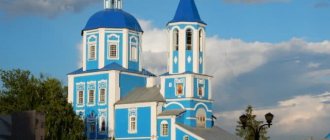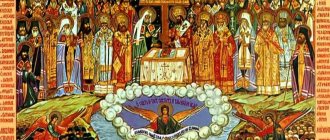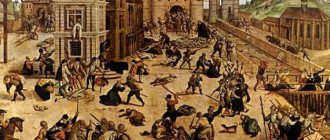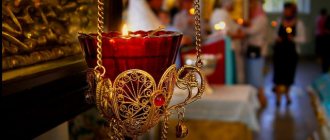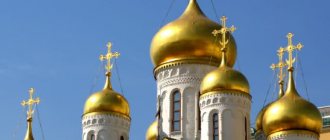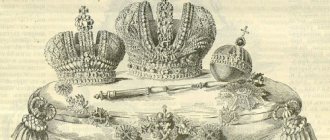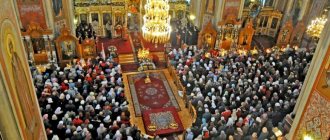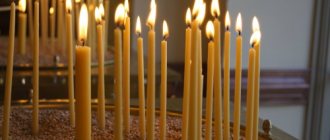The diocesan bishop is the head of a separate Christian community. He is also called the bishop. In ancient times such people were the senior companions of the followers of Christ. Along with the apostles, they helped Christianity to establish itself while the world was being reborn. If traveling preachers carried the Word of God to other nations, then bishops helped it to germinate in places where they had already sown the seed of the Good News. What is the role of the diocesan bishop in the Russian Orthodox Church today? Let's talk about it!
The first Christian bishop is called the Apostle James, the brother of the Lord
The first Christian bishop is often called the Apostle James. This is not Jacob of Zebedee, but Jacob the brother of the Lord. There is practically no debate about the historicity of this man, because Josephus mentioned him in his writings.
According to legend, the Apostle James of the 70s is the first Christian bishop
Clement writes that Peter and John chose James as bishop of Jerusalem. Researchers suggest that this happened around 34. The Apostle James was the chairman at the first Jerusalem Council (approximately 48–50 AD)
Jacob
first bishop of Jerusalem. Chosen by Peter and John in 48-50
Tradition describes Jacob as an ascetic and ascetic, equally respected by both Christians and Jews.
The bishopric of the Apostle James lasted approximately 30 years, and around the year 64, his enemies threw him from the wing of the Jerusalem Temple and stoned him. The apostle is credited with two religious texts - canonical and apocryphal - as well as the composition of the liturgy of the Apostle James.
By the III–IV centuries. the position of diocesan bishop was formed - a bishop at the head of the diocese
In the 2nd–3rd centuries. the function of the bishop in Christianity acquires greater clarity. At least that's how it looks today, through the centuries. Sources clearly describe what a bishop is - this is a hierarchical degree of clergy that heads the spiritual institution that governs the diocese. A priest of this level governs the Church, instructs others and performs the sacraments. He is also the chairman of the Councils. We know for sure that there should have been only one bishop in each Church.
About the bishop of the first centuries we can highlight the following information:
- He is chosen by the people according to the will of the Holy Spirit.
- A bishop cannot be married.
- The candidate is at least 50 years old.
- The bishop protects the Church from schisms.
- He is the representative of Christ.
Finally, over time, dioceses are established. A diocese is an ecclesiastical administrative-territorial unit governed by a bishop. It does not necessarily coincide territorially with the urban community and can unite several such areas. Or, on the contrary, the region can be divided into separate dioceses.
Varieties of bishops appear:
- Ruling Bishop,
- Vicar, that is, a bishop without territory. He performs the functions of a bishop (liturgical, teaching, etc.), but is subordinate to the ruling bishop.
Note: it is not always possible to equate the concepts of diocesan bishop and bishop.
Bishop is a spiritual rank. It does not necessarily imply the management of any diocese, although most often bishops are engaged in this activity.
A diocesan bishop is, rather, a position, an occupation. Anyone who is appointed to it must first be consecrated as a bishop.
By III–IV, the connection between the churches becomes closer, so the bishop is no longer the most important position. United district dioceses—metropolises—emerged. Their heads are metropolitans. During the same period, the basic church regulations and principles of the church hierarchy were finally formed.
Russian Orthodox Church
1. The Russian Orthodox Church is divided into dioceses - local Churches, headed by a bishop and uniting diocesan institutions, deaneries, parishes, monasteries, metochions, monastic hermitages, religious educational institutions, brotherhoods, sisterhoods, missions.
2. Dioceses are established by decision of the Holy Synod, with subsequent approval by the Council of Bishops.
3. The boundaries of dioceses are determined by the Holy Synod.
4. In each diocese there are diocesan administration bodies that operate within the limits determined by the canons and this Charter.
5. To satisfy church needs, the necessary institutions may be created in dioceses, the activities of which are regulated by regulations (statutes) approved by the Holy Synod.
1. Diocesan bishop
6. The diocesan bishop, by succession of power from the holy apostles, is the head of the local Church - the diocese, canonically governing it with the conciliar assistance of the clergy and laity.
7. The diocesan bishop is elected by the Holy Synod, receiving a decree from the Patriarch of Moscow and All Rus'.
8. As needed, the Holy Synod appoints vicar bishops to assist the diocesan bishop with the range of responsibilities determined by the Regulations on Diocesan Vicariates, or at the discretion of the diocesan bishop.
9. Bishops bear a title that includes the name of the cathedral city. Bishop's titles are determined by the Holy Synod.
10. Candidates for bishops are elected at least 30 years of age from among monastics or unmarried white clergy with mandatory tonsure as a monk. The elected candidate must correspond to the high rank of bishop in moral qualities and have a theological education.
11. Bishops enjoy all the fullness of hierarchical power in matters of doctrine, sacred rites and shepherding.
12. The diocesan bishop ordains and appoints clergy to their place of service, appoints all employees of diocesan institutions and blesses monastic tonsures.
13. The diocesan bishop has the right to accept into the clergy of his diocese clergy from other dioceses with letters of leave, as well as to release clergy to other dioceses, providing, at the request of the bishops, their personal files and letters of leave.
14. Without the consent of the diocesan bishop, not a single decision of the diocesan government bodies can be implemented.
15. The diocesan bishop may address archpastoral messages to the clergy and laity within his diocese.
16. The duty of the diocesan bishop is to submit to the Patriarch of Moscow and All Rus' an annual report in the prescribed form on the religious, administrative, financial and economic state of the diocese and on his activities.
17. The diocesan bishop is the authorized representative of the Russian Orthodox Church before the relevant state authorities and local governments on issues related to the activities of the diocese.
18. Carrying out governance of the diocese, the bishop:
a) takes care of maintaining the faith, Christian morality and piety;
b) oversees the correct performance of divine services and the observance of church splendor;
c) bears responsibility for the implementation of the provisions of this Charter, resolutions of the Councils and the Holy Synod;
d) convenes the diocesan meeting and the diocesan council and presides over them;
e) if necessary, exercises the right of veto on decisions of the diocesan meeting with subsequent transfer of the relevant issue for consideration by the Holy Synod;
f) approves the civil charters of parishes, monasteries, farmsteads and other canonical units included in the diocese;
g) in accordance with the canons, visits the parishes of his diocese and exercises control over their activities directly or through his authorized representatives;
h) has senior management supervision over diocesan institutions and monasteries included in his diocese;
i) oversees the activities of the diocesan clergy;
j) appoints (dismisses) rectors, parish priests and other clergy;
k) submits for approval by the Holy Synod candidates for the positions of rectors of religious educational institutions, abbots (abbesses) and governors of monasteries of diocesan subordination and, based on the decision of the Holy Synod, issues decrees on the appointment of these officials;
l) approves the composition of parish meetings;
m) partially or completely changes the composition of the parish meeting if members of the parish meeting deviate from the canonical rules and regulations of the Russian Orthodox Church, as well as if they violate the parish charter;
n) decides to convene a parish meeting;
o) approves (dismisses) from office the chairmen of audit commissions and treasurers of parishes elected by the parish assembly;
p) removes from the parish councils members of parish councils who violate canonical norms and parish statutes;
c) approves financial and other reports of parish councils and parish audit commissions;
r) has the right to appoint (dismiss) the chairman of the parish council, assistant rector (church warden) with their inclusion in (removal from) the parish meeting and the parish council;
s) approves the minutes of parish meetings;
t) provides vacations to the clergy;
x) takes care of improving the spiritual and moral state of the clergy and raising their educational level;
c) takes care of the training of clergy and clergy, in connection with which it sends worthy candidates for admission to religious educational institutions;
h) monitors the state of church preaching;
w) petitions the Patriarch of Moscow and All Rus' to reward worthy clergy and laity with appropriate awards and, in accordance with the established procedure, awards them himself;
y) gives a blessing for the establishment of new parishes;
e) gives a blessing for the construction and repair of churches, houses of worship and chapels and takes care that their appearance and interior decoration correspond to the Orthodox church tradition;
j) consecrates temples;
i) has care for the state of church singing, icon painting and applied church arts;
z1) petitions government and administrative bodies for the return of churches and other buildings and structures intended for church purposes to the diocese;
z2) resolves issues related to the ownership, use and disposal of diocese property;
z3) manages the financial resources of the diocese, concludes contracts on its behalf, issues powers of attorney, opens accounts in banking institutions, has the right of first signature of financial and other documents;
z4) exercises control over the religious, administrative and financial activities of parishes, monasteries, educational institutions and other divisions of the diocese;
z5) issues its own executive and administrative acts on all issues of the life and activities of the diocese;
z6) confirms that all parishes, monasteries and other canonical divisions of the diocese located on its territory belong to the headed diocese;
z7) takes care directly or through the relevant diocesan institutions:
- about works of mercy and charity;
- on providing parishes with everything necessary for performing divine services;
- about meeting other church needs.
19. Monitoring canonical order and church discipline, the diocesan bishop:
a) has the right of paternal influence and discipline in relation to clergy, including punishment by reprimand, removal from office and temporary prohibition in the priesthood;
b) admonishes the laity, if necessary, in accordance with the canons, imposes bans on them or temporarily excommunicates them from church communion. Serious offenses are referred to the ecclesiastical court;
c) approves the penalties of the church court and has the right to mitigate them;
d) in accordance with the canons, resolves issues arising during church marriages and divorces.
20. The dowager diocese is temporarily governed by a bishop appointed by the Patriarch of Moscow and All Rus'. During the period of widowhood of the bishop's see, no business is undertaken regarding the reorganization of diocesan life, and no changes are made in the work begun during the period of administration of the previous bishop.
21. In the event of widowhood of the diocese, transfer of the ruling bishop or his retirement, the diocesan council creates a commission that begins to audit the diocesan property and draws up an appropriate act for the transfer of the diocese to the newly appointed bishop.
22. Church property, which the bishop possessed by virtue of his position and position and which is located in the official bishop's residence, after his death is entered into the inventory book of the diocese and passes to it. The personal property of a deceased bishop is inherited in accordance with current laws.
23. A diocese cannot be widowed for more than forty days, except in special cases when there are sufficient grounds for extending the widowhood.
24. Diocesan bishops are given the right to absent themselves from their dioceses for valid reasons for a period of no more than 14 days, without first seeking permission from the highest church authorities; for a longer period, bishops request such permission in the prescribed manner.
25. The content of diocesan bishops is determined by the Holy Synod. Upon leaving service, they are assigned a bishop's pension, the amount of which is determined by the Holy Synod.
26. Upon reaching the age of 75, the bishop submits a request for retirement to the Patriarch of Moscow and All Rus'. The question of when to satisfy such a petition is decided by the Holy Synod.
2. Diocesan vicariates
27. A diocesan vicariate is a canonical division of a diocese, uniting one or more deaneries of the diocese.
28. The diocesan bishop has the highest authority over the management of the vicariate.
29. A vicar bishop is appointed to a position (removed from office) upon the proposal of the diocesan bishop by determination of the Holy Synod.
The vicar bishop assists the diocesan bishop in the administration of the diocese. The powers of the vicar bishop managing the vicariate are determined by the Regulations on diocesan vicariates, approved by the Holy Synod, as well as written or oral instructions of the diocesan bishop.
To assist the diocesan bishop, suffragan bishops who do not administer vicariates may also be appointed. Their powers are determined by written and oral instructions of the diocesan bishop.
30. The vicar bishop is ex-officio a member of the diocesan council and the diocesan assembly of the diocese with the right of casting vote.
31. To carry out his activities, the vicar bishop:
a) convenes a meeting of the clergy of the vicariate;
b) creates a council and records management service for the vicariate.
The meeting of clergy of the vicariate and the council of the vicariate are advisory bodies under the vicar bishop.
32. The assembly of clergy of the vicariate consists of clergy from all canonical divisions of the vicariate.
The powers, as well as the procedure for the activities of the meeting of clergy of the vicariate, are determined by the Regulations on diocesan vicariates.
The decisions of the meeting of clergy of the vicariate come into force after their approval by the diocesan bishop.
33. The Vicariate Council includes:
a) suffragan bishop;
b) deans of the districts that are part of the vicariate;
c) confessor of the vicariate;
d) one clergyman elected for a term of three years by the meeting of clergy of the vicariate from each deanery that is part of the vicariate;
e) no more than three clergy at the discretion of the diocesan bishop.
The chairman of the vicariate council is the vicar bishop. The secretary of the vicariate council is a member of the vicariate council, appointed to this position by order of the vicar bishop.
The composition of the vicariate council is approved by the diocesan bishop.
The powers, as well as the procedure for the activities of the vicariate council, are determined by the Regulations on diocesan vicariates.
The decisions of the vicariate council come into force after their approval by the diocesan bishop.
34. A secretariat may function under the vicariate, whose employees are appointed by order of the vicar bishop.
35. The head of the secretariat of the vicariate is subordinate to the vicar bishop and is appointed by him to the position.
3. Diocesan Assembly
36. The diocesan assembly, headed by the diocesan bishop, is the governing body of the diocese and consists of clergy, monastics and laity living in the territory of the diocese and representing the canonical units that are part of the diocese.
37. The diocesan meeting is convened by the diocesan bishop at his discretion, but at least once a year, as well as by decision of the diocesan council or at the request of at least 1/3 of the members of the previous diocesan meeting.
The procedure for convening members of the diocesan assembly is established by the diocesan council.
Vicar bishops are ex-officio members of the diocesan assembly with voting rights.
38. Diocesan meeting:
a) elects delegates to the Local Council;
b) elects members of the diocesan council and diocesan court;
c) creates the necessary diocesan institutions and takes care of their financial support;
d) develops general diocesan rules and regulations in accordance with conciliar decrees and decisions of the Holy Synod;
e) observes the course of diocesan life;
f) hears reports on the state of the diocese, on the work of diocesan institutions, on the life of monasteries and other canonical units that are part of the diocese, and makes decisions on them;
g) considers annual reports on the activities of the diocesan council.
39. The chairman of the diocesan meeting is the diocesan bishop. The diocesan meeting elects a deputy chairman and a secretary. The vice-chairman may preside over the meeting at the direction of the chairperson. The secretary is responsible for preparing the journals of the meetings of the diocesan assembly.
40. The quorum of the meeting is a majority (more than half) of the members. Decisions are made by majority vote. In case of equality of votes, the vote of the chairman is decisive
41. The diocesan assembly works in accordance with the adopted regulations.
42. The journals of the meetings of the diocesan meeting are signed by the chairman, his deputy, the secretary and two members of the meeting elected for this purpose.
4. Diocesan Council
43. The Diocesan Council, headed by the diocesan bishop, is the governing body of the diocese.
The diocesan council is formed with the blessing of the diocesan bishop and consists of at least four persons in the priestly rank, half of whom are appointed by the bishop, and the rest are elected by the diocesan assembly for three years.
Vicar bishops are ex-officio members of the diocesan council with voting rights.
44. If members of the diocesan council violate the doctrinal, canonical or moral norms of the Orthodox Church, as well as if they are under ecclesiastical court or investigation, they are removed from their positions by decision of the diocesan bishop.
45. The chairman of the diocesan council is the diocesan bishop.
46. The Diocesan Council meets regularly, but at least once every six months.
47. The quorum of the diocesan council is a majority of its members.
48. The Diocesan Council works on the basis of the agenda presented by the chairman.
49. The chairman presides over the meeting in accordance with the adopted rules.
50. The bishop appoints the secretary of the diocesan council from among its members. The secretary is responsible for preparing materials necessary for the council and compiling minutes of meetings.
51. If disagreements arise during the consideration of a case, the case is decided by a majority vote; In case of equality of votes, the vote of the chairman is decisive.
52. Journals of meetings of the diocesan council are signed by all its members.
53. The Diocesan Council, in accordance with the instructions of the diocesan bishop:
a) carries out the decisions of the diocesan meeting that fall under the jurisdiction of the council, reports to it on the work done;
b) establishes the procedure for electing members of the diocesan assembly;
c) prepares meetings of the diocesan meeting, including proposals for the agenda;
d) submits its annual reports to the diocesan meeting;
e) considers issues related to the opening of parishes, deaneries, monasteries, production and economic activities, governing bodies and other divisions of the diocese;
f) takes care of finding funds to satisfy the material needs of the diocese, and, if necessary, parishes;
g) determines the boundaries of deaneries and parishes;
h) considers the reports of deans and makes appropriate decisions on them;
i) oversees the activities of parish councils;
j) considers plans for the construction, major repairs and restoration of churches;
k) keeps records and takes measures to preserve the property of the canonical divisions of the diocese, including buildings of churches, houses of worship, chapels, monasteries, and religious educational institutions;
l) within the limits of its competence, resolve issues related to the ownership, use and disposal of the property of parishes, monasteries and other canonical units of the diocese; real estate of canonical units included in the diocese, namely buildings, structures, land plots, can be alienated only on the basis of a decision of the diocesan council;
m) carries out an audit of diocesan institutions;
o) takes care of provision for casual clergy and church workers;
o) discusses preparatory activities for anniversaries, general diocesan celebrations and other important events;
p) resolves any other matters that the diocesan bishop sends to the diocesan council for their resolution or for study in order to provide it with the necessary recommendations;
c) considers issues of liturgical practice and church discipline.
5. Diocesan administrations and other diocesan institutions
54. The diocesan administration is the executive body of the diocese, under the direct supervision of the diocesan bishop and called upon, together with other diocesan institutions, to assist the bishop in the exercise of his executive power.
55. The bishop carries out senior management supervision over the work of the diocesan administration and all diocesan institutions and appoints their employees in accordance with the staffing table.
56. The activities of diocesan administrations, like other diocesan institutions, are regulated by regulations (statutes) approved by the Holy Synod and by episcopal orders.
57. Each diocesan department must have an office, accounting, archive and the required number of other departments providing missionary, publishing, social and charitable, educational, restoration and construction, economic and other types of diocesan activities.
58. The secretary of the diocesan administration is responsible for the records management of the diocese and, within the limits determined by the diocesan bishop, assists him in the management of the diocese and in the management of the diocesan administration.
6. Deanery
59. The diocese is divided into dean districts headed by deans appointed by the diocesan bishop.
60. The boundaries of deaneries and their names are determined by the diocesan council.
61. The duties of the dean include:
a) concern for the purity of the Orthodox faith and the worthy church and moral education of believers;
b) monitoring the correct and regular performance of divine services, the splendor and decorum in churches, and the state of church preaching;
c) concern for the implementation of decrees and instructions of the diocesan authorities;
d) care for the timely receipt of parish contributions to the diocese;
e) giving advice to clergy both regarding the performance of their duties and regarding their personal lives;
f) eliminating misunderstandings between the clergy, as well as between the clergy and the laity, without formal legal proceedings and with a report on the most significant incidents to the ruling bishop;
g) preliminary investigation of church offenses at the direction of the diocesan bishop;
h) petition to the bishop for awards to clergy and laity deserving of encouragement;
i) making proposals to the ruling bishop to fill the vacant positions of priests, deacons, psalm-readers and regents;
j) taking care of satisfying the religious needs of believers in parishes that temporarily do not have clergy;
k) monitoring the construction and repair of church buildings within the deanery;
l) concern for the presence at churches of everything necessary for the correct performance of divine services and normal parish office work;
m) fulfillment of other duties assigned to him by the bishop.
62. Carrying out his duties, the dean, at least once a year, visits all the parishes of his district, checking the liturgical life, the internal and external condition of churches and other church buildings, as well as the correct conduct of parish affairs and the church archive, getting acquainted with the religious moral state of believers.
63. On the instructions of the diocesan bishop, at the request of the rector, the parish council or the parish meeting, the dean may hold meetings of the parish meeting.
64. With the blessing of the diocesan bishop, the dean can convene priests for fraternal conferences to consider church needs common to the deanery.
65. Every year the dean submits to the diocesan bishop a report on the state of the deanery and on his work in the prescribed form.
66. Under the dean there may be an office, the employees of which are appointed by the dean with the knowledge of the diocesan bishop.
67. The activities of the dean are financed from the funds of the parish he heads, and, if necessary, from general diocesan funds.
Today in Orthodoxy all representatives of the highest clergy are bishops
In the modern Orthodox tradition, the role of the bishop is clearly defined. He is the direct successor of the apostles. This means that the disciples of Christ ordained their followers, and those, through generations, ordained the current head of the church. When we call a bishop a bishop, we mean that he is the leader of the priests, that is, the priests.
The venerated and oldest bishops are called archbishops.
A metropolitan is technically also a bishop. Only this is the head of the metropolis. A metropolitanate is a union of several dioceses with their own synod. There may also be a metropolitan at a branch of the Russian Orthodox Church abroad - for example, in the USA.
The head of the church is the patriarch. In essence, he is also a bishop or vicar of the Moscow diocese, but on a larger scale.
Chapter ΙΙ. Church authorities
Vicar bishops.
Vicars are bishops who do not have an independent diocese and are attached to diocesan bishops as assistants. A similar institution of vicars existed in ancient times (chorebiscopes).
The proposal to establish suffragan bishops was expressed at the Great Moscow Council in 1667; The first example of the implementation of this assumption was made in 1708, when a vicar was given to the Archbishop of Novgorod and at the same time to the Metropolitan of St. Petersburg. During the reign of the Emperor. Catherine II established vicars at the most important departments of the Russian Church, and on December 17, 1865, it was allowed to establish vicariates in all dioceses, where local sources of their maintenance could be indicated, without burdening the state treasury (non-staff vicariates). Vicar bishops are completely dependent on the diocesan bishop and carry out all his instructions and orders. In the event of a vacancy in the episcopal see, the vicar governs the diocese until a new diocesan bishop is appointed.
2. Spiritual consistories.
Already in the very first centuries of Christianity, bishops had special councils as temporary institutions; Since the 3rd century, permanent councils have appeared under bishops, the meaning and scope of which is precisely determined by the rules of the councils of the 5th century. (Kare 419 and Chalcis 451). In the 8th century we find this council quite established, under one name or another, in every episcopal see of the Eastern Church.
Such councils under bishops have existed for a long time in our Rus' (“consecrated council”). The name “spiritual consistory” first appears in the decree of the Emperor. Elizaveta Petrovna dated June 9, 1744, and the current charter of spiritual consistories was published on March 27, 1841 (in 1883 the second revised edition of this charter was published).
According to this charter, the spiritual consistory is a public place through which, under the direct command of the diocesan bishop, administration and spiritual judgment are carried out in the diocese.53 The presence of the consistory, depending on the boundaries of the diocese, consists of 5 or more members elected by the bishop from among the archimandrites, abbots, hieromonks and priests confirmed in their positions, as well as those dismissed by the saints. Synod.54 – The office of the consistory is under the command of a secretary, appointed and dismissed by St. by the Synod, upon the election and proposal of the Chief Prosecutor.55 – The presence of the consistory occurs on the first five days of the week; on Saturdays only in case of especially important matters; there are no presences during the entire first and last week of Lent, and in the remaining weeks of this fast on Fridays; further from December 24 to 29 and from January 4 to January 9 inclusive.56
The following matters are subject to the consistory:
1) protection and maintenance of the Orthodox faith; 2) supervision of the improvement of churches and their splendor; 3) monitoring the deanery of churches and monasteries and the performance of their duties by the clergy; 4) judgment about the ability of priesthood candidates for church service; 5) supervision over the management of church and monastery property; 6) spiritual court, in which the decisions of the consistory are subject to the approval of the diocesan bishop.
3. Deans.
Deans represent the body of the church-police power of the bishop and in the old days were called “priestly elders.” Their responsibilities were first defined by Stoglav himself. 1551, and then, with a special instruction issued by Patriarch Adrian in 1699 and corrected in 1775 by Plato (later Metropolitan of Moscow).
As a general rule, the dean is elected by the diocesan bishop from candidates submitted by the consistory. The supervision of the dean is entrusted with from 10 to 30 churches with their clergy; if the dean is entrusted with more than 15 churches located over a large area, then an assistant may be assigned to him.
The authority of the dean extends not only to the clergy, but also to the parishioners. Regarding the first, the instruction instructs deans to ensure that the clergy behave in accordance with the dignity of their title, fulfill church duties without neglect, especially the most important divine services and services of civil significance, and regularly maintain parish confessional records and metric books. The dean must immediately report any malfunctions to the bishop. – Regarding the parishioners of his district, the dean has the obligation to take care of their preservation of the purity of the Orthodox faith and the fulfillment of their Christian duty. The dean supervises the clergy and parishioners of the district through personal inspection of the churches entrusted to his supervision twice a year.
Monasteries that are not removed from the subordination of diocesan bishops are under the supervision of special deans of monastic abbots - archimandrites.
